Nitric oxide (NO)-mediated mechanisms of neuronal dysfunction induced through traumatic brain injuries
Traumatic brain injury is a major source of health loss and disability worldwide, particularly among young people. In the brain, one of the main consequences of the insult can be the release of glutamate and its accumulation in the extracellular fluid (EF), the activation of neuroinflammation by damage-associated molecular patterns (DAMPs) and pathogen-associated molecular patterns (PAMPs). Our main aim is to investigate mechanisms underlying neurotoxicity and cell death in injured brain. Our current research focuses on excitotoxicity and ferroptosis, both induced by elevated extracellular glutamate levels, as a consequence of OGDHC inhibition in cortical primary cells.
Some patients with traumatic brain injury have presented subarachnoid hemorrhage (SAH) with increased levels of nitrite in the brain tissue. DAMPs and PAMPs can activate microglia, which causes neuroinflammation, and increased production of nitric oxide (NO). In patients with SAH and hypoxia, nitrite can be converted into NO. NO can diffuse into the cells and inhibit the activity of important enzymes of the tricarboxylic acid (TCA) cycle in mitochondria. We have shown that oxoglutarate dehydrogenase complex (OGDHC) is the most sensitive to NO enzyme. Under physiological conditions, glutamate is converted into 2-oxoglutarate by the reversible enzyme glutamate dehydrogenase, and used in the TCA cycle to produce energy. Under pathophysiological conditions, when the OGDHC enzyme is blocked, 2-oxoglutarate can accumulate and be converted back into glutamate, increasing its intracellular concentration and leading to mitochondria dysfunction.
A part of the glutamate will be packed into vesicles and it will participate in the signal transmission, the remaining will accumulate in the cytoplasm and diffuse into the EF. The excessive accumulation of glutamate in the EF will inhibit the influx of cysteine through the Xc antiporter, reducing the intracellular cysteine concentration and by consequence the activity of the glutathione peroxidase (GPX) enzymes, which is an enzyme family that normally reduces the oxidative stress by neutralizing the lipid peroxides. The accumulation of lipid peroxides together with iron induces ferroptosis.
Parts of this study have already been published. For detailed information see, for example, “Oxoglutarate dehydrogenase complex controls glutamate-mediated neuronal death”, Weidinger et. al., Redox. Biol. 2023 Jun;62:102669.doi: 10.1016/j.redox.2023.102669.
